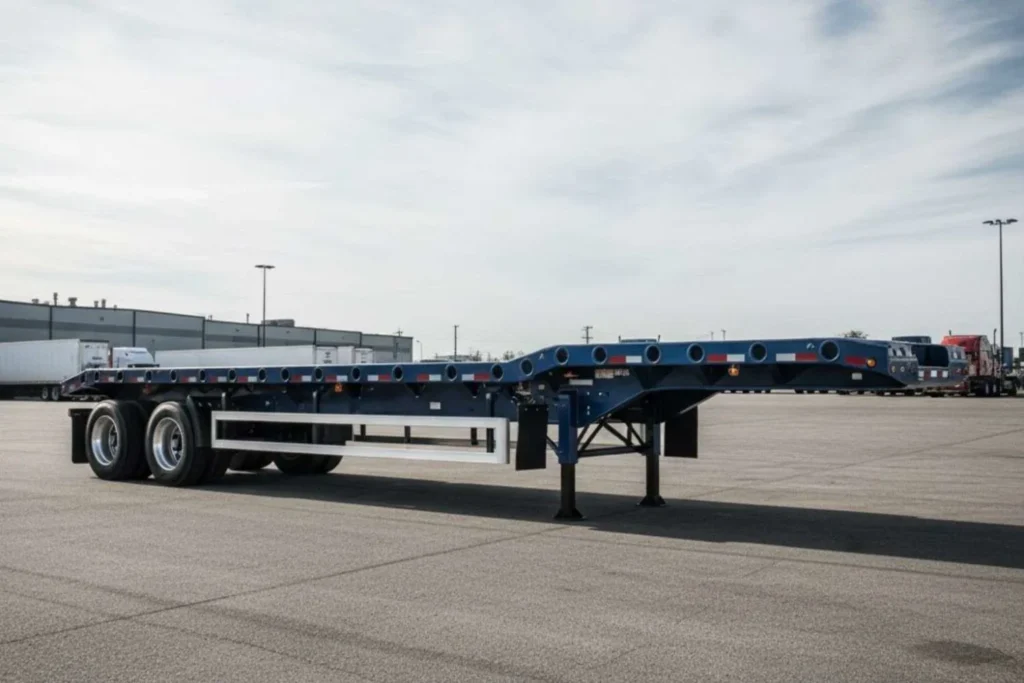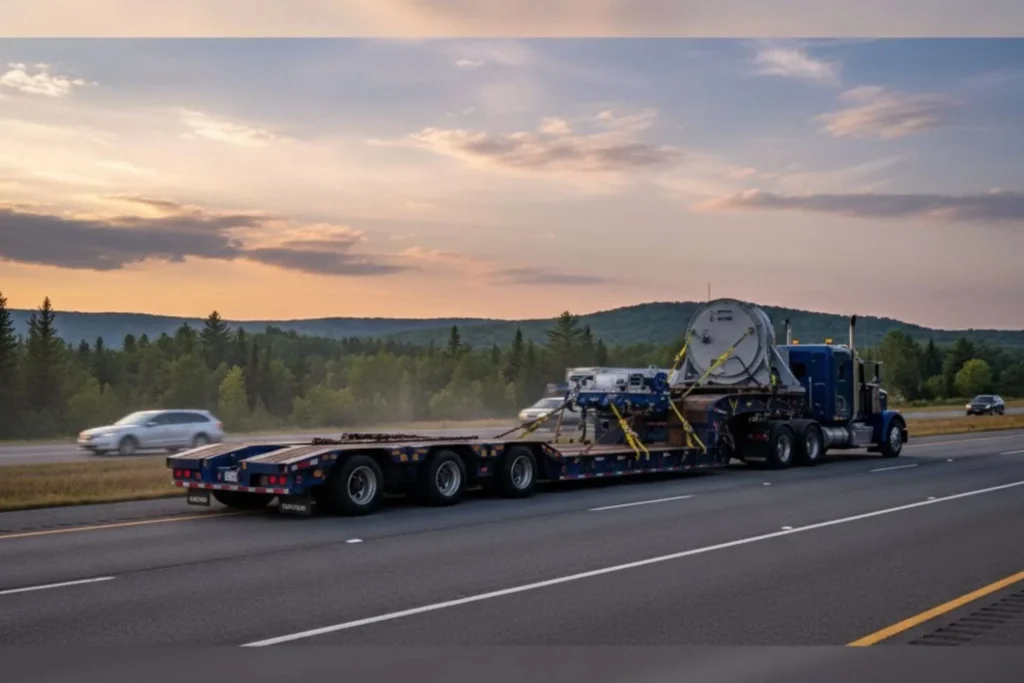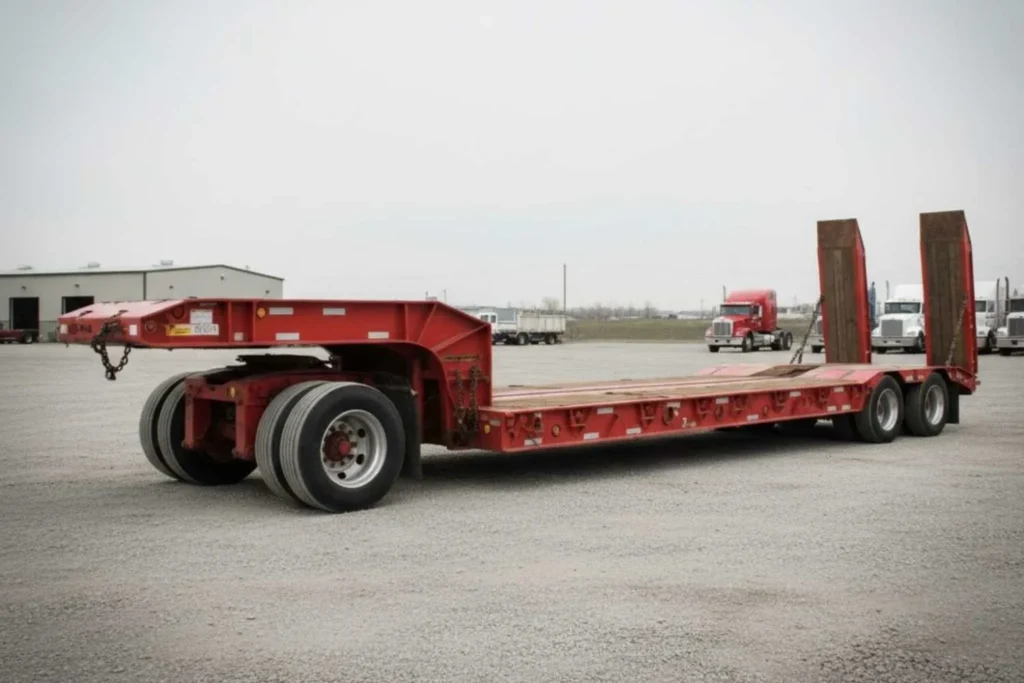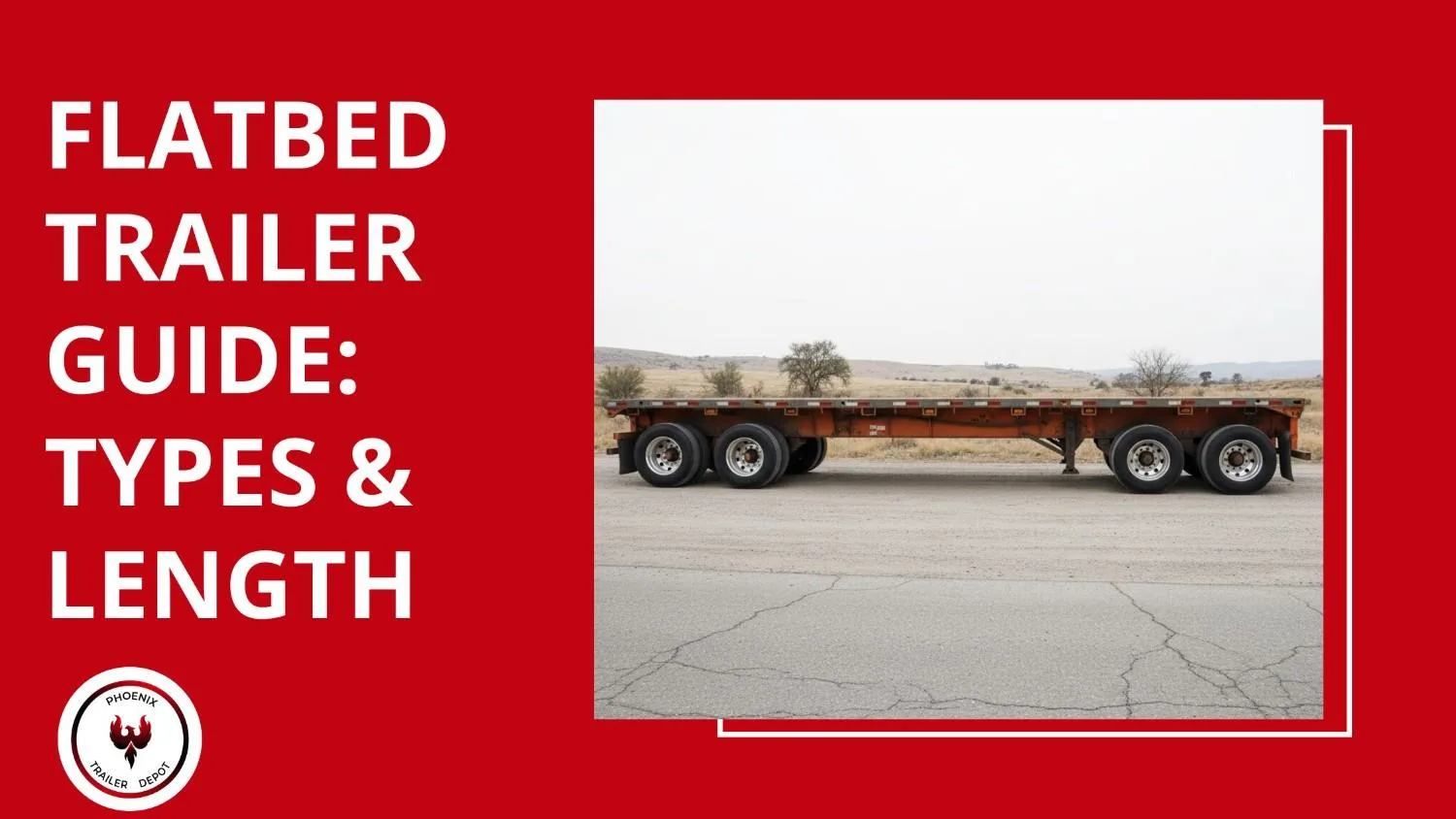Ever wonder those long trucks on the highway without a roof and a wall…what are they? That hero is a flatbed trailer.
Flatbed trailers are the workhorses of the road – carrying everything from steel beams to hay bales and wind turbine parts. Their open design gives them unmatched versatility, but that same openness also brings confusion. With so many sizes, deck heights, and regulations, it’s easy to pick the wrong one and end up with wasted money or, worse, a safety issue.
In this guide, we’ll clear up that confusion once and for all. By the end, you’ll know exactly which flatbed trailer fits your job, your vehicle, and your legal limits. Let’s break it down, one flatbed at a time.
What is a Flatbed Trailer?
A flatbed trailer is exactly what it sounds like – a long, flat, open platform on wheels. No sides, no roof, no enclosure. It’s designed this way so cargo of nearly any shape or size can be loaded from the sides, rear, or even from above with a crane or forklift.
Compared to enclosed trailers that protect items from weather but limit space, flatbeds are all about accessibility. And unlike step decks that have two levels, standard flatbeds have one continuous surface. This simplicity makes them the go-to for hauling materials that don’t fit neatly into a box.
Key takeaways:
- Flatbeds are open trailers with no sides or roof.
- They allow easy loading and unloading from any direction.
- Ideal for oversized, bulky, or oddly shaped loads.
Why Flatbed Trailer Are So Popular?
You’ll find flatbed trailers in nearly every industry because of their unmatched flexibility. Builders use them to haul lumber and scaffolding. Farmers rely on them for tractors and hay. Manufacturers ship steel coils or heavy equipment.
Loading is quick – no fiddling with doors or ramps. You can pull up a forklift from any angle and get to work. Plus, the open design means you can carry tall or wide loads that wouldn’t fit in an enclosed trailer.
And here’s a bonus: flatbeds are often cheaper to maintain. Fewer panels mean fewer things that can rust, dent, or need repair.
Key takeaways:
- Perfect for industrial, agricultural, and construction transport.
- Fast loading and unloading.
- Lower maintenance than enclosed trailers.
Common Challenges Faced by Buyers and Operators
Despite their benefits, flatbeds come with a learning curve. New buyers often struggle with deck height – which affects what you can legally haul. Misjudging the load’s height or width can land you in violation of DOT rules.
Then there’s the issue of weight distribution. Load too much on one side or over a single axle, and you risk poor handling or fines. Some people also overlook local and federal regulations on load securing – a major safety concern.
Key takeaways:
- Know your trailer’s height, width, and weight limits.
- Follow DOT securement rules to avoid violations.
- Choose the right size and axle setup for your cargo.
Major Types of Flatbed Trailers
1. Standard Flatbed Trailer
This is the most common type, often 48 to 53 feet long and about 8.5 feet wide. You’ll see them hauling lumber, machinery, or steel pipes on highways every day.
Their simplicity makes them cost-effective and easy to use, but here’s where many new buyers trip up – payload capacity. A trailer may be long enough for your load, but that doesn’t mean it can safely carry the weight. Always check the trailer’s Gross Vehicle Weight Rating (GVWR) and match it with your cargo’s weight.
Key takeaways:
- Standard lengths: 48–53 feet.
- Ideal for lumber, steel, and general freight.
- Don’t overestimate payload capacity – weight rating matters most.
2. Step Deck (Drop Deck) Flatbed Trailer
Think of a step deck as a flatbed with two levels. The upper deck connects to the truck, then it drops down to a lower main deck. This design allows you to haul taller cargo – like tractors or large equipment – without exceeding height limits.
They’re safer for taller loads, but there’s one big mistake people make: not checking clearance when pulling into docks or under bridges. A few inches too tall, and you’ve got a serious problem.

Key takeaways:
- Two deck levels allow taller loads.
- Great for machinery or construction equipment.
- Always confirm height clearances for docks and bridges.
3. Double Drop Trailer
This trailer drops even lower in the middle, forming a “well” or recessed center. It’s perfect for oversized height loads like industrial tanks or excavators.
However, the lower middle section means you’ll need special loading equipment. Many new operators underestimate how tricky it can be to get equipment in and out safely.

Key takeaways:
- Best for oversized, tall machinery.
- Requires specialized loading gear.
- Suited for experienced operators.
4. Extendable Flatbed (Stretch Trailer)
When your load is longer than a standard trailer – think pipes, beams, or wind turbine blades – you need a stretch trailer. These can extend to 80 feet or more.
They’re versatile but tricky. Improperly secured extensions can wobble or cause imbalance on the road. Always ensure locking pins and safety chains are checked before driving.
Key takeaways:
- Adjustable length for extra-long cargo.
- Common in energy and construction industries.
- Requires careful securing of extended sections.
5. Removable Gooseneck (RGN) Trailer
RGNs are designed with a detachable front that lets equipment drive directly onto the trailer. They’re ideal for heavy machinery like bulldozers and excavators.
They’re powerful and practical but come at a higher cost – both upfront and in maintenance. For someone just starting out, an RGN might be more trailer than you need.
Key takeaways:
- Detachable front for easy loading of vehicles.
- Perfect for heavy machinery.
- Expensive to buy and maintain.
6. Lowboy Flatbed Trailer
Lowboys have an extremely low deck, which allows them to haul the heaviest and tallest cargo legally possible. They’re commonly used for construction or mining equipment.
But with great capacity comes great regulation. You’ll need proper permits and sometimes even escort vehicles for oversized loads.

Key takeaways:
- Lowest deck height for tall or heavy loads.
- Often requires special permits.
- Similar to RGNs but better for extreme weights.
Flatbed Trailer Lengths and Dimensions
A. Standard Lengths and Widths
Flatbed trailer generally come in three standard lengths: 40ft, 48ft, and 53ft. The 48ft version is the industry favorite because it balances capacity with maneuverability.
All standard trailers are 8.5 feet wide – anything beyond that requires special permits and sometimes escort vehicles.
Key takeaways:
- Common lengths: 40ft (light loads), 48ft (standard), 53ft (maximum).
- Width limit: 8.5ft without permit.
- Oversized loads need special approval.
B. Height and Weight Capacity
The typical deck height for a standard flatbed trailer is around 5 feet. Step decks drop closer to 3.5 feet, and lowboys can go as low as 18 inches.
The legal height limit for most U.S. roads is 13 feet 6 inches, including the cargo. Weight limits usually cap at 48,000 pounds, but check your state’s rules – they can vary.
Key takeaways:
- Deck height affects how tall your load can be.
- U.S. legal height: 13’6” (cargo + trailer).
- Weight limits vary by state and axle count.
C. Axle Configurations and Their Role
A trailer’s axle setup determines how much it can carry. Tandem axles (two) are standard, but tri-axles (three) support heavier loads. Choosing the wrong setup can hurt your towing vehicle or cause legal trouble.
Key takeaways:
- More axles = higher load capacity.
- Tandem = standard use; tri-axle = heavy loads.
- Axle setup affects fuel efficiency and legal weight distribution.
Key Uses of Flatbed Trailers
1. Construction and Industrial Hauling
Flatbeds are a staple in construction. They carry steel beams, scaffolding, and machinery to and from job sites. For large excavators or cranes, step decks or lowboys are better suited.
Key takeaways:
- Ideal for construction materials and equipment.
- Use lowboys or RGNs for oversized machinery.
- Ensure proper load securing at each site.
2. Agricultural Applications
From hay bales to tractors, flatbeds are essential on farms. Farmers love their simplicity, especially when transporting bulky goods over short distances.
The biggest challenge? Balancing payload weight across uneven rural terrain. Always double-check tire pressure and suspension when driving off-pavement.
Key takeaways:
- Great for hay, feed, and farm machinery.
- Adjust load for uneven ground.
- Maintain tires and suspension regularly.
3. Vehicle and Machinery Transport
If you’re hauling vehicles or equipment, RGNs and lowboys are your best bet. Their low decks and ramps make loading easy and safe.
Always secure machinery using rated chains and binders – straps alone won’t cut it for heavy equipment.
Key takeaways:
- Use RGNs or lowboys for vehicles.
- Always follow DOT securement standards.
- Inspect tie-downs before each trip.
4. Oversized and Specialized Loads
When it comes to wind turbines, modular homes, or massive tanks, specialized flatbeds step in. These hauls require permits and often escort vehicles.
Plan your route ahead – bridge clearances and road width can make or break your trip.
Key takeaways:
- Specialized loads need permits.
- Route planning is essential.
- Escort vehicles ensure safety and compliance.
Choosing the Right Flatbed Trailer for Your Needs
Step 1: Define Your Cargo and Frequency
Are you hauling once a year or every week? One-time users often buy trailers far too large. If your hauling is occasional, renting might make more sense.
Key takeaways:
- Know how often you’ll use it.
- Don’t overbuy for rare jobs.
- Renting can save money for light users.
Step 2: Match Trailer Type to Cargo
Each trailer type has a best-fit scenario. For example:
| Trailer Type | Best For |
| Standard Flatbed | Lumber, general freight |
| Step Deck | Machinery, tall loads |
| Double Drop | Oversized height cargo |
| Extendable | Beams, pipes |
| RGN | Heavy vehicles |
| Lowboy | Extreme heavy loads |
Key takeaways:
- Match trailer to cargo shape, weight, and height.
- Don’t assume one size fits all.
- Reference before purchase or rental.
Step 3: Check Towing Vehicle Compatibility
Your truck must handle the trailer’s weight plus the cargo. Check your Gross Combined Weight Rating (GCWR) before hooking up. Also, ensure the hitch type – gooseneck or fifth-wheel – matches.
Key takeaways:
- Match GCWR with total load.
- Use proper hitch setup.
- Balance towing vehicle and trailer weight.
Step 4: Understand Legal Requirements
Each state has different limits for width, height, and weight. Oversized permits can take days, so plan ahead.
Key takeaways:
- Check local and federal regulations.
- Secure permits for oversize loads.
- Avoid fines through route planning.
Step 5: Evaluate New vs. Used Options
Used trailers can save thousands, but inspect for rust, deck wear, and brake condition. A well-maintained used flatbed can perform like new.
Key takeaways:
- Inspect used trailers carefully.
- Check tires, brakes, and decking.
- Don’t ignore maintenance history.
Common Mistakes and How to Avoid Them
The biggest mistake? Overloading. Not only is it dangerous, but it can also wreck your suspension and attract DOT fines.
Another common issue: ignoring maintenance. Tires, lights, and brakes wear fast on long hauls. Lastly, don’t cheap out on tie-downs – they’re your cargo’s lifeline.
Key takeaways:
- Avoid overloading.
- Stick to maintenance schedules.
- Invest in quality tie-down equipment.
Maintenance and Safety Best Practices
Regular inspections should become second nature. Check brakes, tires, lighting, and decking before every trip.
Follow DOT securement rules – every 10 feet of cargo needs at least one tie-down. In bad weather, watch for rust and wood rot on decks.
Key takeaways:
- Inspect before every haul.
- Follow tie-down regulations.
- Protect against weather damage.
Conclusion
Flatbed trailers are the backbone of heavy transport. But owning or operating one successfully takes more than horsepower – it takes knowledge. Knowing which type fits your cargo, understanding weight laws, and keeping up with maintenance will save you time, money, and frustration down the road.
When you choose smart – matching the right trailer to the right job – you don’t just move freight, you move efficiently, safely, and profitably.
FAQs
1. What’s the most common flatbed trailer size?
The 48-foot flatbed is the industry standard – versatile, easy to maneuver, and fits most hauls.
2. Do I need a special license to haul a flatbed trailer?
For commercial use or heavier loads, yes – a CDL is required if the combined weight exceeds 26,000 pounds.
3. How long do flatbed trailers last?
With regular maintenance, a quality flatbed can last 15–20 years or more.
4. Can I haul a car on a flatbed trailer?
Yes, but use proper ramps, wheel straps, and balance the weight evenly across the deck.





Leave a Reply